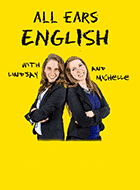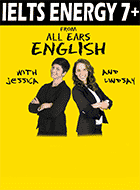Have you heard somebody refer to something as “at your 12:00?”
Is this one of those things in English that you find hard to understand?
This is a reference that may come up often in conversation, and so you want to know how to use it.
The idea came up recently about doing an episode about how we use clock images to locate something around us, for example “Do you see that bird in the tree? It’s at your 6:00.”
We’re going to talk you through these references, help you to understand how to use a clock as the basis, and how you can use this in conversation.
Get Your Transcripts Today!
Make sure you understand every word you hear on All Ears English.
Bring your English to the advanced level with new vocabulary and natural expressions.

Subscribe and get the transcripts delivered by email.
Learn to speak naturally with the American accent.
Click here to subscribe and save 50%
Using A Clock To Tell Someone Where Something Is Located
So what is this idea all about?
Why is it helpful?
Instead of being vague with directions, this allows you to be more accurate and give people a point of reference.
We imagine the person we are talking to is at the center of a clock, so then take the time to picture a clock.
Then we point out something specific based on where the hands would be.
For example, 3:00 would be to the person’s right, and then 9:00 would be to the person’s left.
This gives you them a point of reference for understanding where something is located.
It gives you a point of reference for offering insight as to where something you are referring to is.
If you can picture a clock and ultimately put the person you are talking to in the middle of it, then this analogy works really well.
When Might You Use This?
So you can understand how this reference works, and that it may be useful sometimes.
As with everything, you want to see firsthand how to use such a reference.
There are some times and instances where you may find this clock reference to be very useful, so let’s look at them so you can begin to try this out in conversation.
- When someone can’t see something: If you are trying to point something out and they can’t see it readily, then this reference can come in handy. It can help to give them that point of reference that they need to figure out the location and then they can understand.
- To secretly tell someone where something is: You may be trying to tell somebody where something is, but you’re trying to keep it quiet. Think of this like in a bar setting where you are trying to point out an attractive person. You are trying to be secretive and tell them where to look, and you want to do it in the right way so the clock reference is perfect here.
- In a military type of situation: You may hear this used in a military or even aviation type of situation or setting. It can give a point of reference in a very important situation here.
How Would You Say This?
So you see the instances where you may use this reference, but you have to consider how to say it.
How would you say this and get the reference across just right?
Here’s a couple of examples that you could use in this area that help to convey the reference perfectly.
- “There’s the sign I was looking for. Look. You don’t see it? It’s at your 2:00.”
- You can just say the number as it’s simple and to the point. “Wow, that girl has a beautiful smile. 4:00.”
- Another example could be ”I’m standing at your 7:00– do you see me?”
There are some numbers that are obvious like 12, 3, 6, 9, and these are really helpful in being exact.
You can actually picture their placement on the clock, and so that’s the whole point of the reference.
There are however some numbers that are not as obvious and so they don’t work well, mostly because we don’t have language for this.
Let’s break these down so that you can envision what the placement is on the clock, and then how you can use this in conversation.
- For 12: You can say “right in front of you” or “straight ahead” as this is like the top or start of the clock.
- For 3: You can say “to your right” as it would appear on a clock if you are looking at it straight on.
- For 6: You can say “right behind you” as it would be the opposite of 12 on a clock, such as behind or at the bottom of it.
- For 9: You can say “to your left” as it is the opposite of 3 and therefore the other way.
So you can always use these with a clock, but you have other ways to say them.
This sort of reference works really well for these four numbers as they all have a very obvious placement on a clock.
The other numbers don’t really work as there is no obvious placement or way to refer to them.
You could get into using words such as “diagonal” or “perpendicular”, but then the reference to the clock itself is really lost.
Stick with the four main numbers as they have a very real placement, and they work well to point people in the right direction.
Takeaway
Using a clock for giving directions is very cool sounding, fun, fresh, and unique.
It helps to give that point of reference that you need in the moment.
It works well in pointing something out to somebody you are talking to, and it’s a great handy reference.
This is a great way to take your English to another level, and so it’s a really great thing to practice.
This is a fun way to reference things, and you should try it out in your conversations.
If you have any questions, please leave them below in the comments section.
We’ll get back to you as soon as we can.








